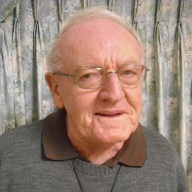50 Years Ago Melbourne Eucharistic Congress, the Aboriginal Mass

Do you remember or, if you don't, did you know of this historic Mass at the 1973 Eucharistic Congress - and the contribution of the local NT and WA aboriginal people and the MSC/OLSH connections?
Sunday 24th February marks the 50th anniversary of the Aboriginal Mass celebrated during the Eucharistic Congress in Melbourne in 1973.
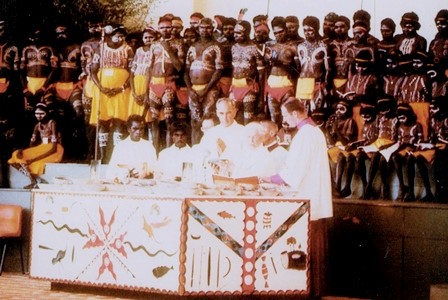
The pictorial record of the Eucharistic Congress, Congress of the People, Melbourne, Australia, 18-25 February 1973 commended the occasion:
The Australian Aboriginal Liturgy celebrated at the Sidney Myer Music Bowl on Saturday afternoon, February 24 and attended by nearly 30,000 people was one of the most memorable occasions at the Congress week. Cardinal Sheehan, the Papal Legate, celebrated the Mass at an altar decorated with Aboriginal symbols. Aboriginal singers and dancers from north and west of Australia took an active part in a celebration which broke new ground in the Church's liturgical renewal.
The Advocate, Melbourne's Catholic paper of the day described the preparations and the celebration of the Liturgy in a number of articles and is the main source of the following.
Archbishop Knox, Melbourne's Archbishop, had commissioned Fr Hilton Deakin to explore areas in which Aborigines could make a special contribution to the Congress and from which they themselves might benefit.
Fr Brian Morrison of the Blessed Sacrament Fathers, as the co-ordinator of the Aboriginal Liturgy had recently travelled to the Northern Territory to celebrate the liturgy as finally drawn up and approved by the Holy See.
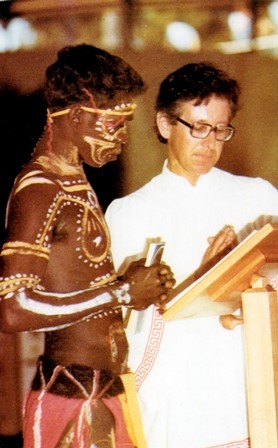
The Aboriginal Mass contained a number of innovations.
The first scripture reading was replaced by a mime of the Last Supper, performed by the 24 dancers under the direction of Fr Michael Sims msc from Bathurst Island and accompanied by rhythmical chanting and clapping.
Michael Sims MSC
In place of the Responsorial Psalm, Claude Narjic from Port Keats, sang his own composition in praise of Christ. The song in the Marringar (Murrinyngarr) dialect was accompanied by music from a didjeridoo, a set of clapping sticks, and a guitar.
The Eucharistic prayer itself contained a number of innovations. Allan Havelock cp writing in the Advocate stated that a feature of the Canon was the simple, non-theological yet meaningful language and the Eucharistic prayer proper added to the community participation with an increased number of acclamations. He added that the words "happy" and "friends" are numerous throughout the text and reflect the community preoccupation of the aborigines.
During Communion, Port Keats' Aboriginals sang several songs in language and the children's choir, some 45 girls and boys between eight and 13, and a highlight of the celebration sang a hymn under the direction of Sr Francesca olsh.
Some 30 men who had been brought to the Congress by Fr Brian Healy msc joined with dancers from Kununurra WA to perform the thanpa (Djanba) dance, a high spirited dance in thanksgiving.
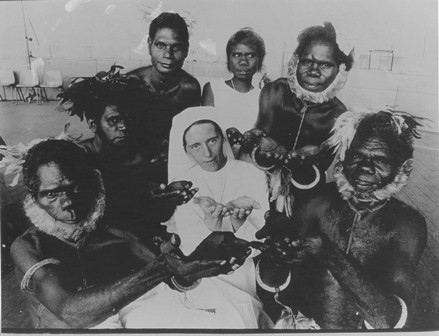
The altar was painted with the special emblems and designs by the men from Port Keats area.
The chalice was made in the shape of a coolamon, a traditional ""carry-all"" vessel. It was specially made for the Congress by Aboriginals from the Pallotine Mission station near Broome.
Cardinal Sheehan's vestments, were made by Bathurst Islanders and designed by a 20 year old Tiwi artist Bede Tungutalum who said it depicted the Holy Spirit with the Apostles.
Photo acknowledgements: MDHC Archdiocese of Melbourne.
Article and photos sent by Leo Wearden MSC, Wadeye.
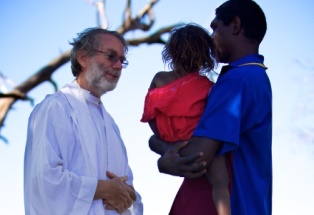
Leo adds that this weekend there will be celebrations at Wadeye and Bathurs Island with those who were present 50 years ago.
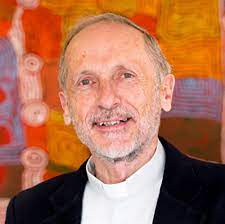
Brian McCoy SJ draws on his long experience in the NT with a fine article in this week’s edition of Eureka Street.
Brian has tabled a great deal of information about the creation of that liturgy and he notes:
This group numbered more than one hundred and fifty adults, teenagers and a children’s choir.
This liturgy was, for many of us who were present, the first time we had witnessed and experienced Aboriginal people expressing their Catholic faith in ways that were culturally different from our own but very significant to them. The ancient Catholic liturgy took on a new dimension of life and energy as people sang in their own language, mimed the Word of the Gospel and danced.
This first public and national Aboriginal Liturgy was highly significant. It was the first attempt by the Catholic Church in Australia to re-shape the ancient Catholic ritual of the Mass, which itself had already changed and adapted in the light of Vatican II in the late 1960s. In this case, the attempt was in the light of the faith experiences by those belonging to an even more ancient culture. Or, more accurately, Aboriginal cultures. It was no easy task.
That liturgy on a Saturday afternoon in a Melbourne summer was never intended to be the final word or assume the final shape of a more culturally sensitive and inclusive liturgy. It was only a beginning.
